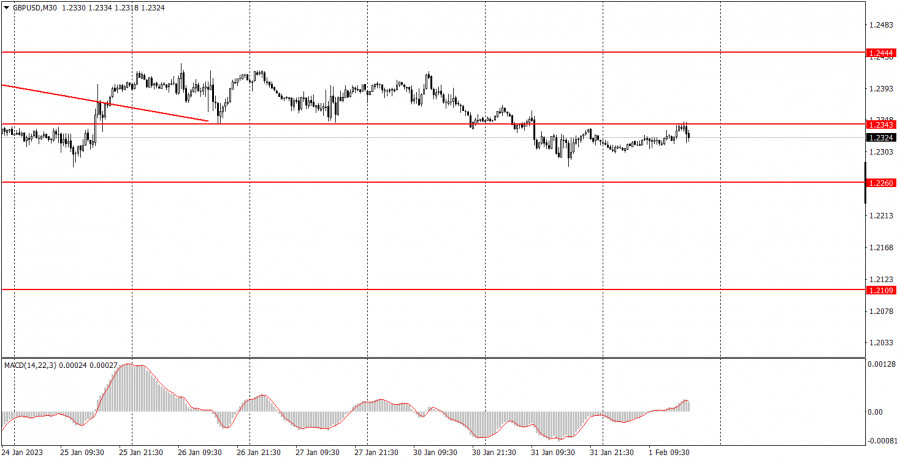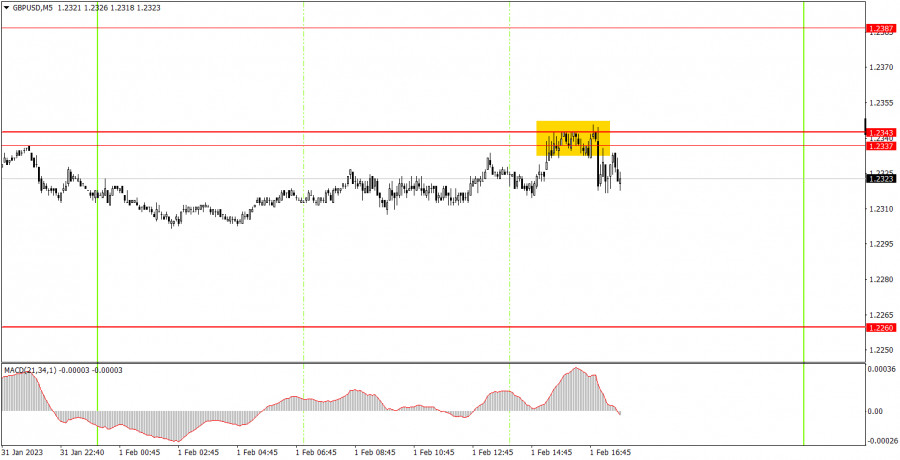Analyzing Wednesday's trades:
GBP/USD on 30M chart
GBP/USD did not show any desire to move. Volatility was about 50 pips, which is a miniscule amount for the pound. There were few macro data, but at least there was something. The UK released its manufacturing PMI, which went up from 45.0 to 47.3 points. This report was blatantly ignored. The US published its ISM manufacturing index, which dropped from 48.4 to 47.4 points. Surprisingly, the US dollar rose slightly after this report. So there was no talk about logical moves or even just moves. The pound is waiting for the results of the Federal Reserve and Bank of England meetings. The reaction to them may be very strong, but at the moment the pound remains inside a sideways channel of 1.2260-1.2444. Since this channel is quite wide, even if volatility increases, the pair may not leave it.
GBP/USD on M5 chart
There was only one signal on the 5-minute chart, and that's fine. The movement was weaker than usual, so if there had been a level in the area of the pair's movement, we would have received a lot of false signals. But in practice, the price reached the 1.2337-1.2343 area, which it bounced from, only in the beginning of the US trading session. Therefore, novice players could open a short position. It did not bring much profit, as it is already possible to close it manually, so as not to take the risk. But it was possible to earn some 10 pips.
Trading tips on Thursday:
On the 30-minute chart, GBP/USD continues to move within the 1.2260-1.2444 channel. I expect volatility to increase during the US central bank's announcement and Fed Chairman Jerome Powell's speech. On the 5-minute chart, it is recommended to trade at the levels 1.2064-1.2079, 1.2109, 1.2171-1.2179, 1.2245-1.2260, 1.2337-1.2343, 1.2387, 1.2444-1.2471, 1.2577-1.2597. As soon as the price passes 20 pips in the right direction, you should set a Stop Loss to breakeven. On Thursday, the results of the BoE meeting will be announced in the UK, as well as the speech of BoE Governor Andrew Bailey. These two events may be enough for the pair to move very actively during the day. At the same time, the market will continue to work out the results of the Fed meeting.
Basic rules of the trading system:
1) The strength of the signal is determined by the time it took the signal to form (a rebound or a breakout of the level). The quicker it is formed, the stronger the signal is.
2) If two or more positions were opened near a certain level based on a false signal (which did not trigger a Take Profit or test the nearest target level), then all subsequent signals at this level should be ignored.
3) When trading flat, a pair can form multiple false signals or not form them at all. In any case, it is better to stop trading at the first sign of a flat movement.
4) Trades should be opened in the period between the start of the European session and the middle of the US trading hours when all positions must be closed manually.
5) You can trade using signals from the MACD indicator on the 30-minute time frame only amid strong volatility and a clear trend that should be confirmed by a trendline or a trend channel.
6) If two levels are located too close to each other (from 5 to 15 pips), they should be considered support and resistance levels.
On the chart:
Support and Resistance levels are the levels that serve as targets when buying or selling the pair. You can place Take Profit near these levels.
Red lines are channels or trend lines that display the current trend and show in which direction it is better to trade now.
The MACD indicator (14, 22, and 3) consists of a histogram and a signal line. When they cross, this is a signal to enter the market. It is recommended to use this indicator in combination with trend patterns (channels and trendlines).
Important announcements and economic reports that can be found on the economic calendar can seriously influence the trajectory of a currency pair. Therefore, at the time of their release, we recommend trading as carefully as possible or exiting the market in order to avoid sharp price fluctuations.
Beginners on Forex should remember that not every single trade has to be profitable. The development of a clear strategy and money management is the key to success in trading over a long period of time.












